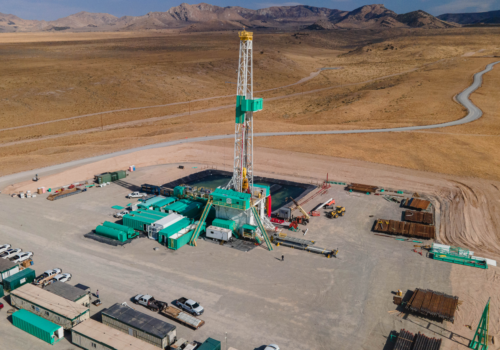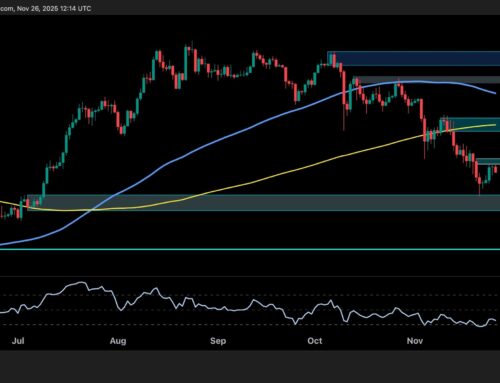How geothermal could enhance US energy security—if prioritized
November 25, 2025
Electricity demand in the United States is rising—along with prices. After nearly a decade of flat growth, the US Energy Information Administration projects that annual demand across the United States will grow 2.4 percent in 2025 and 2.6 percent in 2026. Meeting that demand affordably poses a formidable challenge. Oil and gas markets are volatile, while renewables have intermittency challenges and vulnerable supply chains. In this environment, accelerating the development of geothermal energy could help reduce exposure to these risks.
Compared to solar, wind, or battery storage, geothermal power relies relatively less on critical minerals like cobalt and lithium. And, unlike oil and gas generation, geothermal requires no fuel. As a result, geothermal can provide round-the-clock baseload power with lower exposure to disruptions in global supply chains.
As the cost of enhanced geothermal technologies continues to decrease and their geographic reach expands, now is the time for policymakers, especially in the United States, to take a serious look at geothermal as a key part of their energy security strategy.
Geothermal energy taps the earth’s internal heat for electricity and heating. A traditional geothermal well accesses natural steam and hot water, while an enhanced geothermal system (EGS) fractures hot rock and circulates fluid to absorb subsurface heat. This heat produces steam, which returns to the surface to spin turbines that generate electricity. Traditionally, geothermal energy production was limited to tectonic boundaries or hotspots where the earth’s crust is thin and subterranean heat is at its highest. However, technological advances, including drilling techniques borrowed from the oil and gas sector, have now made geothermal commercially viable in a broader range of locations.
In terms of energy security, geothermal offers two major advantages compared to other sources.
First, it can provide 24/7 baseload power without the need for fuel. Insulated from volatile global commodity markets, geothermal can offer the energy resilience necessary to achieve US energy policy priorities, like independently powering domestic and overseas US military bases and the fast-growing US data center industry. In fact, a growing number of tech giants are signing offtake agreements with geothermal companies to power artificial intelligence (AI) operations, including Meta’s agreements for 150 megawatts (MW) each from Sage Geosystems and XGS Energy, and Google’s agreements with Fervo Energy and NV Energy for 115 MW.
Second, geothermal is not as reliant on vulnerable supply chains as wind and solar are. China controls a high percentage of the global supplies of many minerals that are essential to the manufacture of wind and solar components and systems, especially in midstream refining. According to the International Energy Agency (IEA), for 19 out of 20 strategic minerals, China is the leading refiner, with an average market share of 70 percent. China refines 91 percent of rare earths, 77 percent of cobalt, 70 percent of lithium, 44 percent of copper, and 42 percent of chromium. According to International Aluminum data, it also consistently accounts for around 60 percent of aluminum production.
While geothermal technology uses more chromium than wind and solar, it uses less of other critical minerals, especially when battery storage is added to a system. Geothermal requires less copper and aluminum than solar photovoltaics, and less copper, rare earth minerals, and zinc compared to wind. Adding battery storage to intermittent wind and solar dramatically increases the need for chromium, cobalt, lithium, and rare earths even further for these technologies.
Downstream, the IEA estimates that China’s share in key solar panel manufacturing stages exceeds 80 percent. In terms of wind development, the IEA in its Energy Technology Perspectives 2023 also estimated China accounts for 70 to 80 percent of global blade manufacturing, 45 to 50 percent of tower production, and around 70 percent [SJ8] [PS9] of nacelle (turbine covers) assembly capacity. While geothermal still relies on global markets for standard components like turbines, steel, and piping, its ability to leverage the existing assets and technologies of the US oil and gas sector—primarily for drilling—significantly reduces its exposure to risks in the supply chain.
Geothermal also offers another major advantage: Multiple projects for lithium extraction from geothermal brine in California’s Salton Sea, as well in the Smackover Formation in Arkansas and the Upper Rhine Graben in Europe, show how geothermal could even become a net producer of critical minerals.
Recent support from President Trump and Energy Secretary Chris Wright places geothermal firmly among the administration’s pillars for securing US energy dominance. In a speech in March 2025, Wright suggested that although geothermal “hasn’t achieved liftoff yet, it should and it can,” adding it “could help enable AI, manufacturing, reshoring, and stop the rise of our electricity prices.” Meanwhile, Trump’s executive orders, as recently as July, have consistently identified geothermal as a key resource to be developed and allowed expedited permitting.
This renewed enthusiasm has highlighted key areas for White House and Congressional cooperation:
Permitting reform: Establishing more streamlined permitting processes, including ensuring better interagency coordination and adequate resources would reduce uncertainty and project timelines, directly increasing their bankability.
- Categorical exclusions (CXs): The Bureau of Land Management’s (BLM) could expand on its April 2024 and January 2025 adoption of CXs that exempt certain low-impact, early-stage activities from separate environmental reviews. The US Department of Energy (DOE) estimates that the January 2025 CX alone could shorten the geothermal permitting process by up to a year. Expanding CXs for other early-stage, low-impact activities and allowing concurrent environmental reviews for different phases of the same project would further shorten project timelines, boosting investor appeal.
- Interagency cooperation: Designating one agency to conduct a single, unified review could further accelerate project timelines. Currently, developers must often complete a full environmental review with the BLM and then a second, separate review with the US Forest Service.
- Sufficient staffing: Expeditious permitting also requires adequate staff to process requests, a factor for policymakers to consider amid proposed reductions to the workforce, including in key state offices responsible for federal licensing.
Continued tax credits and research and development (R&D) support:
- Tax credits: The Trump administration’s maintenance of the Inflation Reduction Act’s (IRA) tax credits for geothermal is a win for the sector. Based on National Renewable Energy Laboratory data, the Center for Strategic and International Studies reported that the IRA’s tax credits could lead to the levelized cost of electricity from EGS to drop by nearly 85 percent, to $60 to $70 per megawatt-hour, making it competitive with other firm and intermittent energy sources.
- Federal R&D support: The DOE’s Geothermal Technologies Office has helped advance drilling and reservoir techniques at the Frontier Observatory for Research in Geothermal Energy (FORGE) demonstration laboratory in Utah, but more research is needed. Challenges for EGS include drilling into hot rock, which represents over half the project’s budget and destroys standard equipment. This is compounded by the uncertainty of whether a viable underground fracture network can be successfully engineered to circulate water and extract heat without causing issues like induced seismic disturbances. Sustained federal support for testbeds like FORGE will help overcome these challenges, catalyze advances, reduce costs, and enable the scaling of traditional geothermal and EGS across the United States.
By prioritizing the rapid development of geothermal, policymakers could help the United States build a unique path to energy security—one that delivers reliable power 24/7, insulated from global hydrocarbon markets and vulnerable supply chains.
Paul Stahle is a senior energy advisor and government relations expert with over 18 years of U.S. government experience. His work spans energy and technology policy in Washington, D.C., China, Europe, India, and the Asia-Pacific.
stay connected
related content
our work

The Global Energy Center develops and promotes pragmatic and nonpartisan policy solutions designed to advance global energy security, enhance economic opportunity, and accelerate pathways to net-zero emissions.
Energy & Environment
Renewables & Advanced Energy
United States and Canada
Image: Joint base San Antonio-Lackland, Texas (Bureau of Land Management, New Mexico, https://www.afcec.af.mil/News/Article-Display/Article/3541806/air-force-pioneering-innovative-geothermal-energy-solutions/)
Search
RECENT PRESS RELEASES
Related Post




